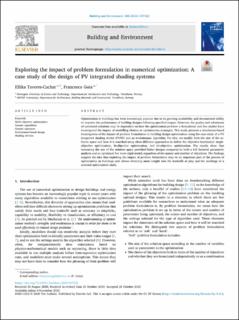| dc.contributor.author | Taveres-Cachat, Ellika | |
| dc.contributor.author | Goia, Francesco | |
| dc.date.accessioned | 2020-12-07T07:20:11Z | |
| dc.date.available | 2020-12-07T07:20:11Z | |
| dc.date.created | 2020-12-03T08:34:02Z | |
| dc.date.issued | 2020 | |
| dc.identifier.issn | 0360-1323 | |
| dc.identifier.uri | https://hdl.handle.net/11250/2712064 | |
| dc.description.abstract | Optimization in buildings has been increasingly popular due to its growing availability and documented ability to improve the performance of building designs following specified targets. However, the quality and robustness of optimized solutions may be dependent on how the optimization problem is formulated, and few studies have investigated the impact of modelling choices or optimization strategies. This study presents a simulation-based investigation of the impact of problem formulation in building design optimization using the case study of a PV integrated shading device (PVSD) and an evolutionary algorithm. For this, we modify both the size of the solution space and how it is searched using three different approaches to define the objective function(s): single-objective optimization, bi-objective optimization, and tri-objective optimization. The results show that increasing the size of the solution space provided better designs compared to both a full factorial parametric analysis and an optimized but more rigid model, regardless of the nature and number of objectives. The findings support the idea that exploring the impact of problem formulation may be an important part of the process of optimization in buildings and allows obtaining more insight into the tradeoffs at play and the workings of a selected optimization study. | en_US |
| dc.language.iso | eng | en_US |
| dc.publisher | Elsevier | en_US |
| dc.rights | CC BY 4.0 | * |
| dc.rights.uri | http://creativecommons.org/licenses/by-nc-nd/4.0/deed.no | * |
| dc.subject | Multi-objective optimization | en_US |
| dc.subject | Genetic algorithms | en_US |
| dc.subject | Genetic operators | en_US |
| dc.subject | Performance-based design | en_US |
| dc.subject | Shading devices | en_US |
| dc.title | Exploring the impact of problem formulation in numerical optimization: A case study of the design of PV integrated shading systems | en_US |
| dc.type | Peer reviewed | en_US |
| dc.type | Journal article | en_US |
| dc.description.version | publishedVersion | en_US |
| dc.rights.holder | © 2020 The authors | en_US |
| dc.subject.nsi | VDP::Teknologi: 500 | en_US |
| dc.source.journal | Building and Environment | en_US |
| dc.identifier.doi | 10.1016/j.buildenv.2020.107422 | |
| dc.identifier.cristin | 1855594 | |
| dc.relation.project | Norges forskningsråd: 255252 | en_US |
| cristin.ispublished | true | |
| cristin.fulltext | original | |
| cristin.qualitycode | 2 | |

